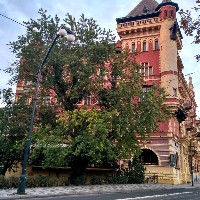Breadcrumbs navigation
Bellevue
The massive building on the corner of Karoliny Světlé Street and Smetana Embankment was built in the Dutch Renaissance style at the end of the 19th century. Due to its location, it was called Bellevue, meaning "a beautiful view" in French. It provides amazing views of the Charles Bridge and Prague Castle. On the top floor there used to be painting studios, one of which was inhabited for some time by the Austrian painter Oskar Kokoschka.
- house
- views
- Monuments & Architecture
Contacts
- Bellevue
- Smetanovo nábřeží 18
- 110 00 Praha 1 – Staré Město
Object history
The Bellevue on Smetana Embankment (Smetanovo nábřeží) was named based on the fact that it has one of the most beautiful Prague views of the Vltava River and Hradčany: Bellevue is a French word meaning a “beautiful view”. The same name was given to a café that was opened there by entrepreneur Filipi after the building completion. Previously, the Papoušek’s Bath (Papouškovy lázně) used to stand there. During the construction of a chain bridge and embankment, all buildings standing there had to be purchased: houses, baths, mills and enclosures. After completion of the bridge and embankment, the rows of residential rental houses were built according to a project by architect Bernard Gruber from 1849. The houses were designed uniformly in a temperate complexion of late Classicism. Only two-storey houses were allowed to be built there, the rule was totally broken by architect Konstantin Mráček while designing the Bellevue house at the end of this row at a triangular site between Smetana Embankment and Karoliny Světlé Street. The house from fair-faced dark red bricks has three wings. Due to the higher terrain into the embankment, the waterfront wing has five floors while the wing towards Karoliny Světlé Street has six floors. The façades of all three wings are richly segmented by balconies, small towers, bay windows and arcades. Numerous architectonic ornaments are also preserved in the interior. The main façade faces the river while the porch of the former Café Bellevue, where there is a restaurant of the same name today, faces the northern side. On the top floor under the roof there used be painting studios. The painter Oskar Kokoschka worked in one of them when he fled Austria in 1934 for Prague because of rising Nazism. After the Munich Agreement in 1938 he even had to leave Prague and retired to London. Later, the painter Jiří Trnka took over his studio. The third wing leads to Poštovská Street. At the northwest corner of the building there is a massive prismatic tower which has a sheltered gallery with a stone baluster railing on the top under the roof. A high slender circular bay window ended by a conic roof has been additionally built to the tower.
Information source: Prague City Tourism



